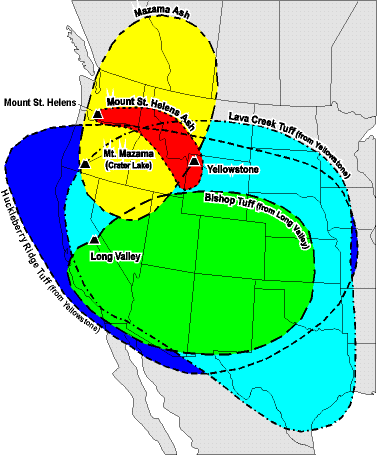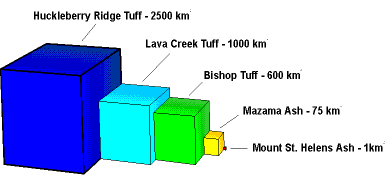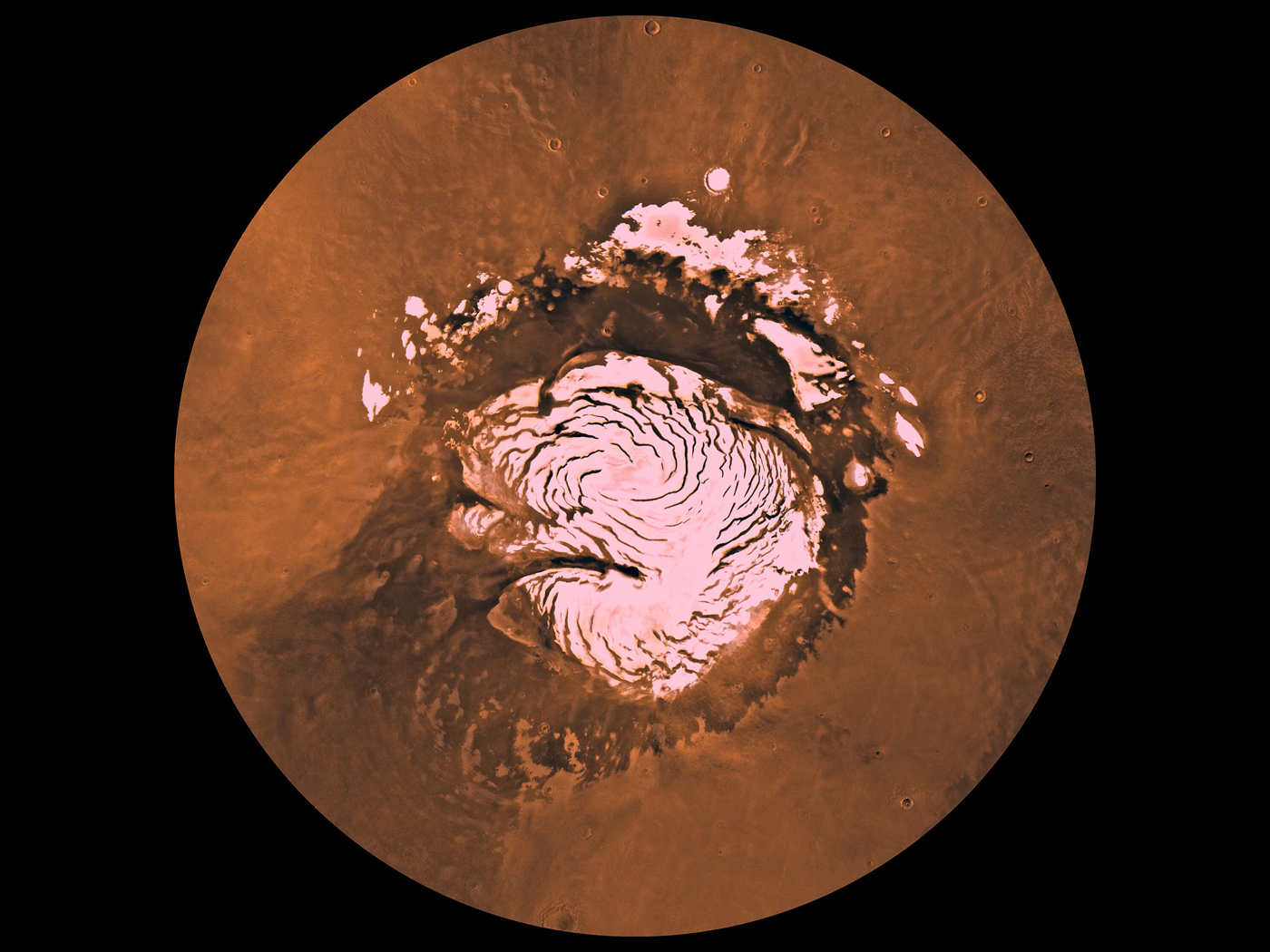"He toucheth the hills, and they smoke" (Psalm 104:32).
Ask a geologist, "What is Yellowstone National Park?" and you are likely to get the answer, "Yellowstone is a gigantic, collapsed volcano." That is the new story now popular at the visitor center at the national park.1 The size and scale of the collapsed volcano are so huge that they prevented the earlier generation of geologists from properly appreciating the ancient explosions which formed Yellowstone's landscape. Aided by satellite photos and detailed geologic maps, a new generation of geologists has recently outlined an elliptical depression which is now interpreted as a caldera, the collapsed crater structure formed after an extremely explosive volcanic eruption. That colossal structure is 75 by 45 kilometers (47 by 28 miles), comprises one-third of the area of the national park, and is appropriately called Yellowstone Caldera. About 1,000 cubic kilometers (240 cubic miles) of rhyolite magma were explosively extruded to form the surrounding volcanic ash deposits.2 These deposits, called the Lava Creek Tuff in figure 1, are mute testimony of the extreme power of a volcanic explosion at Yellowstone.
Yellowstone Caldera is eclipsed by evidence of an even larger volcanic collapse structure at Yellowstone. That larger and older caldera, now largely obscured by later geologic process, extends from Island Park (eastern Idaho) eastward at least to central Yellowstone, more than 100 kilometers (60 miles)! Its explosion products, called the Huckleberry Ridge Tuff in figure 1, formed from the eruption of an astounding 2,500 cubic kilometers (600 cubic miles) of magma.3
How much energy was involved in the biggest eruptions at Yellow-stone? Scaling of the magma volume shows the energy of the biggest Yellowstone eruption was about 3,000 times that of the nine-hour eruption of Mount St. Helens on May 18, 1980. The biggest Yellowstone eruption (»2 million megatons TNT equivalent energy) had more than one hundred times the energy of the world's inventory of nuclear weapons (»12,000 megatons TNT equivalent energy)! Can anyone properly appreciate the colossal size and power of the biggest volcanic explosions which formed Yellowstone? A safe distance to witness an event of such colossal magnitude would be from a higher orbit of the space shuttle!
Other prehistoric explosive eruptions are evidenced by some of the world's largest calderas.4 Most have been recognized in the western United States:
| La Garita Caldera, Colorado (3,000 cubic kilometers), Emory Caldera, New Mexico (1,450-2050 cubic kilometers), Bursam Caldera, New Mexico (1,400 cubic kilometers), Long Valley Caldera, California (600 cubic kilometers), Crater Lake Caldera, Oregon (75 cubic kilometers). |
The largest historic explosive eruption within the last 150 years is Krakatoa (1883) of Sumatra which involved 18 cubic kilometers of magma and produced a six-kilometer-diameter caldera. For comparison, Mount St. Helens (May 18, 1980) of Washington State produced a crater, but no caldera, and released less than one cubic kilometer of magma. Recent earthquake activity at Mammoth, California, may indicate resurgent magma processes at great depth within Long Valley Caldera, but the recent activity there does not demonstrate the magma volume remotely comparable to the ancient explosion process (600 cubic kilometers of Bishop Tuff). Thus, ancient explosive volcanoes have erupted with hundreds to thousands of times the energy and power as their modern counterparts.
There are two ways to view the evidence of the history of Earth's explosive volcanoes. A uniformitarian geologist would be forced by the data to admit the poverty of his experience in the present. He would say that the modern period (Holocene) has been too short to be representative of the earth's potential volcanic fury. He might adopt a rationalist procedure and argue from his presuppositional framework that much bigger eruptions could continue to occur in the future. A thorough-going uniformitarian would say, given enough time, an explosion like Yellowstone is certain to happen again. That is the response Life Magazine got when it interviewed uniformitarian geologists about continuing volcanism at Yellowstone.5
A catastrophist, however, sees the disparity between modern and ancient volcanoes as an empirical phenomenon that needs to be explained. The presuppositional framework of the catastrophist has consistency with the data, not the seeming inconsistency with the uniformitarian's framework. Instead, the catastrophist might look at the smaller explosive eruptions of modern times as indicative of a long-term decline in the energy and power of volcanoes compared to the more distant past. The catastrophist's presuppositional framework anticipates more energetic volcanism and tectonics during and immediately following the global event called Noah's Flood.6 The catastrophist says declining volcanic power with time is what we should see in the geologic record.


| Figure 1. Diagrams illustrate the declining power with time of explosive volcanic eruptions in the post-Flood period. Diagram (a.) shows western North America and illustrates the declining area of ash-fall beds with time. Diagram (b.) illustrates the declining volume of the explosion products with time. |
Is there a way to test uniformitarian and catastrophist interpretations of the history of explosive volcanism? We could compare each framework with the geologic record of non-explosive volcanism seen in lava-flow strata on all continents. The largest historic lava flows have occurred on Iceland. The largest being the eight-month eruption of Laki (1783) in Iceland. Along a crack 25 kilometers long, 12.3 cubic kilometers of basaltic lava flowed through two river valleys and covered an area of 565 square kilometers.7 Historic seafloor volcanoes are not as well understood, but recent seafloor lava flows do not appear to have volumes or rates exceeding the historic terrestrial record.8 The ancient strata, however, show extremely large lava flow events. The largest lava-flow strata of the Columbia River Basalt Group (Miocene) of Washington, Oregon, and Idaho appear to have volumes approaching 3,000 cubic kilometers.9 Even larger flow volumes may exist in the Siberian Traps (Tunguska region of Siberia), Deccan Traps (India), Karoo Province (South Africa), and Newark Supergroup (NE United States).10 Thus, energies of ancient lava-flow volcanoes appear to exceed by a thousand times their modern counterparts. Again, this evidence is consistent with the catastrophist interpretation of the declining power with time of post-Flood volcanoes.
References
1 R. B. Smith and R. L. Christiansen, "Yellowstone Park As a Window on the Earth's Interior," Scientific American, 242 (February 1980): pp. 104-117.
2 Ibid.
3 Ibid.
4 F. J. Spara and J. A. Crisp, "Eruption Volume, Periodicity, and Caldera Area: Relationships and Inferences on Development of Compositional Zonation in Silicic Magma Chambers," Journal of Volcanology and Geothermal Research, 11 (1981): pp. 169-187.
5 D. E. Duncan, J. Miller and M. Murphy, "Volcanoes," Life (June 1996): pp. 52-60.
6 Steven A. Austin, John R. Baumgardner, D. Russell Humphreys, Andrew Snelling, Larry Vardiman, and Kurt P. Wise, Catastrophic Plate Tectonics: A Global Flood Model for Earth History (1996, Geology Education Materials, P.O. Box 712679, Santee, CA 92072) 48 pp. and 80 slide photos.
7 S. Thorarinsson, "The Lakagigar Eruption of 1783," Bulletin Volcanologique, 33 (1970): pp. 910-929.
8 K. C. Macdonald, R. Haymon, and A. Shor, "A 200 km2 Recently Erupted Field on the East Pacific Rise near Lat 8 Degrees S," Geology, 17 (1989): pp. 212-216.
9 T. L. Tolan, et al., "Revisions to the Estimates of the Areal Extent and Volume of the Columbia River Basalt Group," in S. P. Reidel and P. R. Hooper, eds., Volcanism and Tectonism in the Columbia River Flood-basalt Province (1989, Boulder, CO., Geological Society of America Special Paper 239), pp. 1-20.
10 P. R. Renne and A. R. Basu, "Rapid Eruption of the Siberian Traps Flood Basalts at the Permo-Triassic Boundary," Science, 253 (1991): pp. 176-179. A. K. Baksi, G. R. Byerly, L. Chan, and E. Farrar, "Intracanyon Flows in the Deccan Province, India? Case History of the Rajahmundry Traps," Geology, 22 (1994): pp. 605-608. J. G. McHorne, "Broad Terrane Jurassic Flood Basalts across Northeastern North America," Geology, 24 (1996): pp. 319-322. R. E. Ernst, J. W. Head, E. Parfitt, E. Grosfils, L. Wilson, "Giant Radiating Dyke Swarms on Earth and Venus," Earth-Science Reviews, 39 (1995): pp. 1-58.
* At time of publication, Dr. Austin chaired the Geology Department of the ICR Graduate School.
Cite this article: Austin, S. A. 1998. The Declining Power of Post-Flood Volcanoes. Acts & Facts. 27 (8).



















